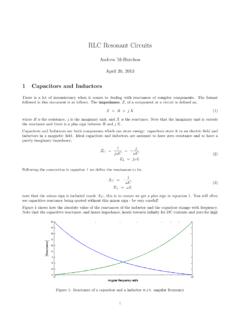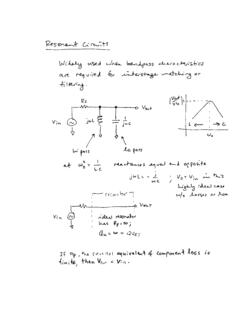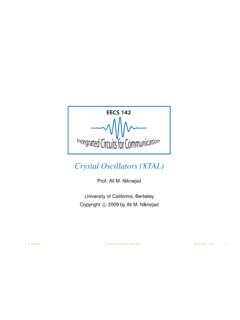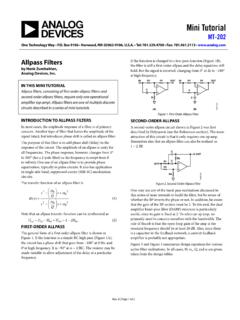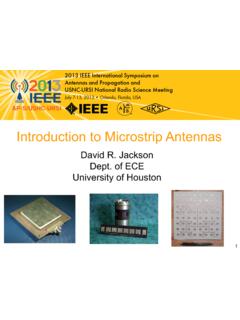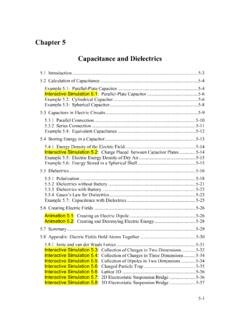Transcription of Series 3000 Cooling Tower
1 Dorsey Run Road, Jessup, MD 20794 Telephone: (410) 799-6200 Fax: (410) 799-6416 2015 Baltimore Aircoil Company M244/7-A-XEOPERATION & MAINTENANCE MANUALS eries 3000 Cooling TowerDANGER: Rotating equipment will cause severe personal injury or death to persons who come in contact. Do not perform any service on or near the fans, motors, and drives, or inside the unit without first ensuring that the fans and pump motors are disconnected, locked out, and tagged out. NOTES:1. Recommended service intervals are the minimum for typical installations. Different environmental conditions may dictate more frequent servicing. Follow all safety and equipment precautions on pages 2 and When operating in ambient temperatures below freezing, the unit should be inspected more frequently. Refer to Cold Weather Operation on page 35 for more Tension on new belts must be readjusted after the first 24 hours of operation and quarterly, Lubricate fan shaft bearings quarterly or every 2,000 hours of operation, whichever occurs Maintenance Service[1]Inspect and clean as necessary:Start-UpMonthlyQuarterlyAnnual lyShutdownInspect general condition of the unit[2] and check unit for unusual noise or vibrationInspect cold and hot water basinsFlush water distribution system/Inspect spray nozzlesDrain basin and pipingInspect air intake louvers/Combined inlet shieldsCheck and adjust water level in cold water basinCheck operation of make-up valveCheck and adjust bleed rateCheck optional EASY CONNECT Piping ArrangementInspect unit finishMechanical equipment system.
2 Start-UpMonthlyQuarterlyAnnuallyShutdown Check belt conditionAdjust belt tension[3]Lubricate fan shaft bearings[4}Lubricate motor base adjusting screwCheck and lubricate optional gear drive or ENDURADRIVE Fan SystemSee Fan Drive System on page 13 for detailed instructions and drive alignmentCheck motor voltage and currentClean fan motor exteriorCheck fan motor for proper rotationCheck general condition of the fanVerify fan blade drain holes are not obstructed (hollow blade fans)Check fan for uniform pitchCheck fan for rotation without obstructionVerify the fan guard is properly installedVerify the operation and function of electric immersion heater and controls, if so equippedCheck and recoat steel shafts with RUST VETO Check optional vibration cutout switchTable of ContentsSafety and Equipment Precautions2 Danger2 Warning2 Caution3 Notice3 General Maintenance Information3 WarrantiesPART 1 Unit Operation and Storage4 Start-Up Procedure6 Extended Shutdown7 Prolonged Outdoor StoragePART 2 Detailed Component Maintenance Procedures9 Cold Water Basin10 Fan11 Fan Drive System20 Fan Guard Installation23 Fan Motors23 Fan Shaft Bearings24 Heat Transfer Section24 Water Distribution System25 Water Level ControlPART 3 Corrosion Protection28 Water Treatment29 Corrosion and Scale Control30 Chemical Treatment Requirements31 Passivation 31 Biological Control31 Long Term Care of Stainless SteelPART 4 Bleed Rate33 Bleed RatePART 5 Cold Weather Operation35 Inspection & Maintenance35 Fan Section]
3 Icing Protection36 Basin Water and Internal Piping Freeze ProtectionPART 6 Operation Considerations for Accessories38 Basin Heater (Optional)39 Stand Alone BAC Heater Control Panel (Optional)40 Vibration Cutout Switch (VCOS)Part 7 Fan Control41 Variable Frequency Drive Operation43 resonant Speed Identification ProcedurePART 8 New Field Connections for TriArmor Corrosion Protection System Cold Water Basin45 Installation InstructionsOPERATION & MAINTENANCE Series 3000 Cooling DANGER: Rotating equipment will cause severe personal injury or death to persons who come in contact. Do not perform any service, maintenance or inspection on or near the fans, motors, and drives, or inside the unit without first ensuring that the fan and pump motors are disconnected, locked out, and tagged out. DANGER: On installations where there are multiple adjacent cells which may be traversed to gain access to another cell, all fan motors must be disconnected, locked out and tagged out, including those on adjacent cells, before performing any service on or near the fans and drive systems, and before traversing adjacent cells.
4 Failure to follow this instruction may result in serious injury or death caused by contact with rotating equipment. DANGER: If the fan guard is removed or if the fan guard installation is altered for any reason, the fan guard must be reinstalled properly in accordance with the instructions contained in this manual before operating the fan. Failure to follow this instruction may result in serious injury or death caused by contact with rotating equipment. WARNING: When access to the top of the unit is desired, the purchaser/end-user is cautioned to use appropriate means to comply with applicable safety standards related to working on elevated surfaces. WARNING: When the fan speed of the unit is to be changed from the factory set speed, including changes achieved by the use of a variable fan speed device, steps must be taken to avoid operation at or near the fan s critical speed which could result in fan failure and possible personal injury or damage.
5 WARNING: The recirculating water system may contain chemicals or biological contaminants, including Legionella, which could be harmful if inhaled or ingested. Personnel exposed directly to the discharge airstream and the associated drift mists, generated during operation of the water distribution system and/or fans, or mists produced by high pressure water jets or compressed air (if used to clean components of the recirculating water system), must wear respiratory protection equipment approved for such use by governmental occupational safety and health authorities. WARNING: All electrical, mechanical, and rotating machinery are potential hazards, particularly for those not familiar with their design, construction, and operation. Accordingly, use appropriate lockout procedures. Adequate safeguards (including the use of protective enclosures where necessary) should be taken with this equipment both to safeguard the public from injury and to prevent damage to the equipment, its associated system, and the premises.
6 WARNING: A lockable disconnect switch should be located within sight of the unit for each fan motor associated with this equipment. Before performing any type of service or inspection, make certain that all power has been disconnected, and the switch is locked out in the OFF position. WARNING: Dangerous voltages are present in this equipment. Disconnect the electrical service of the source and follow proper lock out and tag out procedures to de-energize the circuit before servicing or replacing components. WARNING: To prevent possible contamination of the make-up water supply, install a backflow prevention method in accordance with applicable local and national codes. CAUTION: The operation, maintenance, and repair of this equipment shall be undertaken only by personnel authorized and qualified to do so. All such personnel shall be thoroughly familiar with the equipment, the associated system and controls, and the procedures set forth in this manual.
7 Proper care, procedures, and tools must be used in handling, lifting, installing, operating, maintaining, and repairing this equipment to prevent personal injury and/or property damage. CAUTION: Openings and/or submerged obstructions may exist in the bottom of the cold water basin. Use caution when walking inside this equipment. CAUTION: Follow exposure control and personal protective equipment requirements as outlined in the MSDS for all recommended lubricant and maintenance materials CAUTION: BAC does not recommend field application of aftermarket coatings in the cold water basins of products equipped with electric immersion heaters. The coating material may create an increased risk of fire if the heaters remain energized for any reason without sufficient water in the cold water basin. WARNINGCAUTIONS afety and Equipment The basin heater is not designed to prevent icing during unit operation.
8 The heater control panel temperature/low level control can only be used with the supplied combination temperature/liquid level sensor probe. Please contact your local BAC Representative for replacement parts. For the stand alone BAC heater control panel, do not operate the system unattended or for extended periods of time during test mode (resistor across terminals T1 and T2). Operation in water temperatures above 45 F ( C) could damage the unit. For heater control panels, do not operate the system unattended or for extended periods of time with terminals G1-G2 jumpered. A low liquid level condition could occur, and the system will not shut off which could result in damage to the heater and unit. Ensure the controls for the fan motor are set to allow a maximum of six on-off cycles per hour to prevent motor overload. For fan motors controlled with VFDs with a switching frequency of kHz, the line lead length cannot exceed 100 feet.
9 If the switching frequency is higher than kHz and/or the line lead length exceeds 100 feet, a dV/dT output filter is recommended to protect the motor. When reversing the direction of fan rotation, allow the fan to come to a complete stop before restarting the motor. Only lubricate the bearings with one of the following compatible water resistant greases on page 23. Do not use steam or high pressure water to clean PVC eliminators or materials other than steel. Never use chloride or chlorine based solvents such as bleach or muriatic (hydrochloric) acid to clean stainless steel. It is important to rinse the surface with warm water and wipe with a dry cloth after cleaning. Gear drives should not be used with Wye-Delta (Y- ) motors. For installations with 2-speed motors when slowing from high speed, allow a minimum 15-second time delay for the fan to slow down before energizing the low-speed winding.
10 For towers with optional gear drives, do not mix synthetic lubricants and mineral oils. Attempt to use only one brand of lubricant at all times. If the brand is changed, completely drain the old oil before filling the gear with new oil. Do not use power tools on the whisper quiet fan. The services required to maintain a piece of evaporative Cooling equipment are primarily a function of the quality of the air and water in the locality of the installation: AIR: The unit should be located such that unusual quantities of industrial smoke, chemical fumes, salt, or heavy dust do not enter the equipmment. Such airborne impurities entering nto the equipment and absorbed by the recirculating water, which can form a corrosive solution. WATER: As water evaporates from the equipment, dissolved solids are left behind, which were originally contained in the make-up water.

